Psoriasis or scaly lichenIt is a chronic disease that affects the skin and its appendages: nails and hair. It is characterized by periods of deterioration (relapses) and temporary well-being when the onset of the disease decreases. This disease is not contagious and the patient is not dangerous to others. Because the appearance of psoriasis is not associated with microorganisms.
Psoriasis is most common between the ages of 15 and 45. Light-skinned people are more sensitive to it. In developed countries, the number of people suffering from psoriasis reaches 2-4% of the population. Every 25th inhabitant of the Earth on every continent suffers from this.
Many healthcare institutions are dealing with this problem. Therefore, psoriasis has been recognized as the most studied disease. However, this disease is not fully known. It is officially considered incurable and raises many questions.
Psoriasis is caused by the body's own immune cells. They rise from the lower layers of the skin to the upper ones, causing inflammation, proliferation of epithelial cells, and the formation of small capillaries.
The manifestations of psoriasis on the skin are quite varied. The disease is most often caused by the appearance of red spots - psoriatic plaques. They are dry to the touch, rising above the surface of the skin and covered with a white coating.
Types of psoriasis
The disease can be divided into two major groups: pustular and non-pustular psoriasis.
Non-pustular psoriasis
- common (vulgar) or simple psoriasis (plaque psoriasis, chronic stable psoriasis)
- psoriatic erythroderma or erythrodermic psoriasis
Pustular psoriasis
- pustular psoriasis von Tsumbusch or generalized pustular psoriasis
- palmoplantar psoriasis (pustular psoriasis of the limbs, chronic persistent palmoplantar pustulosis)
- ring-shaped pustular psoriasis
- palmoplantar psoriasis
- herpetic psoriasis impetigo
In addition, these types of psoriasis are distinguished.
- seborrheic psoriasis
- psoriasis of bending surfaces and skin folds
- Psoriasis napkin
- drug-induced psoriasis
According to severity, such forms of psoriasis are distinguished.
- Mild - less than 3% of the skin is affected.
- Moderate - 3-10% of the skin is covered with psoriatic plaques.
- Severe - there are joint changes or more than 10% of the skin is affected.
Causes of psoriasis

To date, there is no clear answer to the question, "why does psoriasis appear? " Scientists have set up several theories.
- Psoriasis is an autoimmune disease. It is based on a malfunction of the immune system. The immune cells of T-killers and T-helpers, which are responsible for protecting the body from viruses, bacteria and tumor cells, penetrate the upper layers of the skin for some reason. Inflammatory mediators are produced here - substances that "trigger" the inflammatory response. It results in increased division and proliferation of skin cells.
- Psoriasis is a disease caused by a violation of the growth, division and maturation of epithelial cells called keratinocytes. As a result of such skin lesions, immune cells of T lymphocytes and macrophages attack diseased skin cells.
Factors contributing to the development of psoriasis
Doctors have identified a number of factors that can cause the disease to appear. Of course, psoriasis is most common when several of these diseases affect the body at the same time.
- Hereditary predisposition.There is a variant in which the genes responsible for the immune system and T lymphocyte function are carriers of the disease. Therefore, parents with psoriasis are more likely to have children who have the same symptoms.
- Thin dry skin. . . It has been found that people with such skin characteristics get sick more often than those with oily and well-hydrated skin. This is probably due to the protective functions of sebum and the structural characteristics of the skin.
- External irritants. . . A large percentage of patients are those who are in constant contact with alcoholic solutions, solvents, household chemicals, cosmetics (water, hand cream).
- Excessive hygiene- Excessive loving cleanliness also undermines the protective properties of the skin. Soaps, shower gels and wipes remove the natural protective layer and leave microscopic damage.
- Bad habits- Alcohol, smoking and drug addiction are harmful to the skin. Your nutrition and blood supply are deteriorating.
- Hiv- AIDS patients are more prone to psoriasis. Scientists cannot explain this phenomenon. The fact is that psoriasis is caused by increased activity of lymphocytes and their numbers are reduced in AIDS.
- Medicines- taking certain medicines may cause illness. Among them: beta-blockers, antidepressants, antispasmodics and antimalarials, lithium carbonate.
- Infections (fungi and staphylococci). . . Psoriasis often occurred immediately after fungal infections or diseases caused by streptococcus.
- Moving- changes in the climate or even the season, the deterioration of the environment can be the cause of this disease.
- Tension- severe emotional shock or physical stress (prolonged hypothermia, overheating, accidents) prevents the onset of the first symptoms of psoriasis.
- Injury- permanent effect on the skin: pressure, friction, scratches. Such regular trauma at this site may cause the appearance of the first psoriatic plaques.
- Allergic conditions- Allergic skin rashes and the processes that occur in them also increase the risk of disease in all layers of the skin.
What are the symptoms and signs of psoriasis?
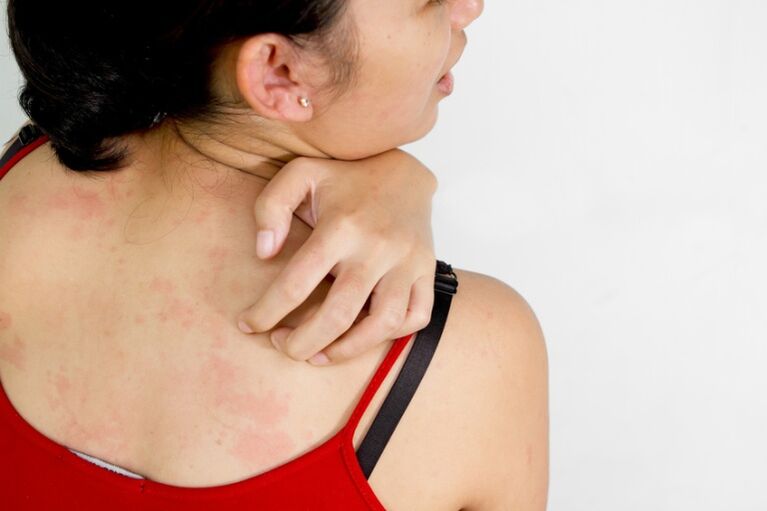
Psoriasis is a systemic disease that affects more than just the skin and nails. It affects the joints, tendons and spine, the immune, nervous and endocrine systems.
But still, the main manifestations of the disease occur on the skin. The name psoriasis accurately describes the symptoms of psoriasis. The first manifestations are often the corresponding rounded shape of pink or bright red papules, covered with scales - psoriasis plaques. They are located symmetrically, mainly on the extensor surfaces, the lower back, and the scalp. But they can affect any part of the skin and genital mucosa. They are a few millimeters to ten centimeters or larger in size in the initial stage.
This is the case depending on the characteristics of the rashforms of psoriasis:
- Pitting psoriasis - the size of the elements is smaller than the head of a pin.
- Guttate psoriasis - the papules are teardrop-shaped and reach the size of a lentil.
- Coin psoriasis - plaques grow to 3-5 mm and have rounded edges.
They also distinguish the forms of rashes when their elements are in the form of rings, arcs, and garlands, geographical maps with uneven edges.
The papules are covered with a scaly coating that is easy to remove. It consists of keratinized cells of the epidermis. Psoriatic plaques are covered with scales from the middle and then the plaque spreads to the edges. Its loose and light appearance is due to the fact that keratinized cells are permeated by air-filled spaces. A pink ring can form around the elements - it is an inflammatory area, a plaque growth zone. The skin around the elements of the rash does not change.
Scalp psoriasismeans psoriatic plaques that rise significantly above the surrounding skin. They are densely covered with dandruff-like scales. In this case, the hair remains intact. Rashes can occur not only under the hair but also on the smooth skin, neck and behind the ears. Such changes are explained by the active division of keratinocytes in the affected areas.
Psoriasis of the feet and palmscauses severe thickening of the stratum corneum of the skin in these areas of the body. The skin will be thick and rough. Cracks often penetrate it. This is due to intense cell division, which multiplies 8 times faster than usual but does not move away from the surface of the skin over time.
Psoriasis nailsit differs in different symptoms. But the most important are the two main types of nail plate damage:
- By type of "thimble". Small pits form on the nail plate, similar to needle puncture marks.
- By type of onychomycosis. The lesions are reminiscent of a fungus. The nails thicken, change color, come off. A psoriatic papule surrounded by a red rim is visible through the nail plate. It looks like an oil stain that shines through your nails.
The symptoms and signs of psoriasis depend on the stage of the disease, which cyclically alternates throughout the year. So most patients have a "winter" type of disease when the exacerbation occurs during the fall-winter period. The improvement in the summer condition is due to the fact that the sun's ultraviolet light has a therapeutic effect. But some patients suffer from the "summer" type.
There are such stages in the course of psoriasis:
- progressive - appearance of new elements, active growth of existing plaques, implicitity of the pink growth zone around them, intense exfoliation and itching.
- fixed - stopping the growth of papules, no new rashes, fine folding of the top layer of skin around the psoriasis plaques.
- regression - the absence of exfoliation, the disappearance of plaques and the appearance of pigmented areas in place indicate a weakening of the process.
What do skin rashes look like with psoriasis?
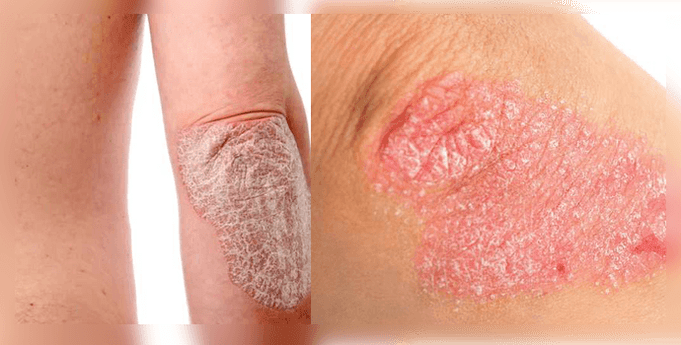
Each organism is unique and responds differently to disease. Therefore, the nature of the rash can be very varied. This explains the variety of forms and types of psoriasis.
However, most people have similar symptoms of psoriasis. These are red spots - psoriatic plaques that rise 1-3 mm above the level of healthy skin. Their appearance is caused by the fact that the cells of the surface layer of the skin - the keratinocytes - divide very actively, they do not have time to mature and become full-fledged epithelial cells. Due to the increased pathological growth, certain areas of the skin thicken. This is due to the fact that immune cells release chemicals that cause inflammation in the skin.
From above, the plaques are covered with gray, silvery, or yellowish inflorescences that appear like paraffin. That is why they were named "Paraffin Lakes". These are keratinized epithelial cells whose rejection is damaged and accumulates on the affected skin surface.
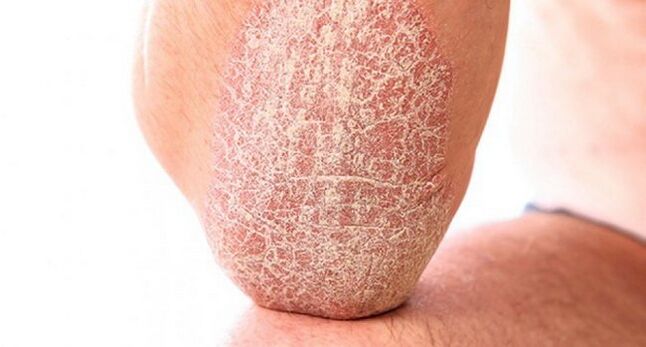
The spots are fluffy, hotter than the rest of the skin and can grow large. Often the patient feels severe itching at this site. This is due to the fact that the inflammatory process is caused by a series of neuro-reflex reactions and an allergic reaction.
Another type of element is papules. These are small elements of the rash that resemble tuberculosis. Its size is about 1 mm. There is no cavity in the middle. They are often located on the knee and elbow joints. They persist even during periods when the disease recedes.
During exacerbations, the elements of the rash gradually widen and merge with adjacent plaques. During the period of improvement (remission), the spots begin to fade from the middle. They gradually take the form of a ring and dissolve completely. After plaques, traces remain on the body - pigmentation. It can be significantly lighter or darker than the surrounding skin. After a person tans, the skin tone usually evens out.
What do nail lesions look like in psoriasis?
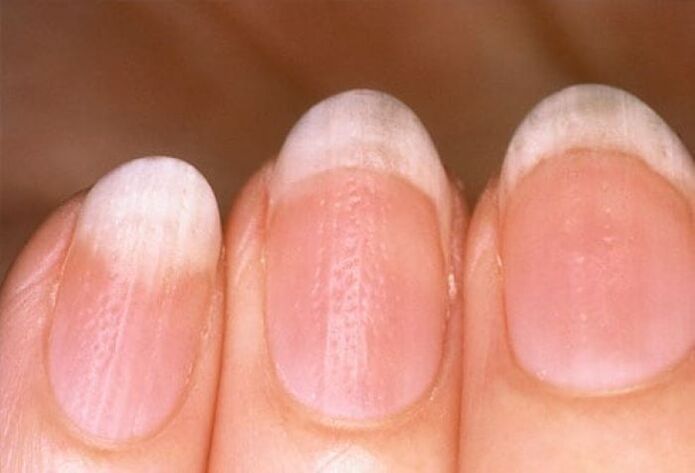
Psoriasis of the nail is similar to a fungal infection of the nail plate. Laboratory analysis should be performed for correct diagnosis. The changes can only affect one or all of my nails at a time and are very varied. They occur in 10-15% of patients. Damage to the nails is often accompanied by joint pain caused by psoriasis. In this case, there may be no skin rash.
There are several stages in psoriasis of the nail:
- depressed dots - thimble nails
- longitudinal indentations
- transverse compression in the middle of the nail, these first signs are related to damage to the nail root - the nail matrix
- "Oil stains" are pink, irregularly shaped patches that appear through the nail - this is the accumulation of whey fluid under the nail
- nails become dull, cloudy, yellow, thickened due to circulatory disorders
- the nail plate takes on the appearance of a bird’s claw, accompanied by pain. This is due to the fact that the process fixes the nerve endings.
The nail lesions begin at the edge and gradually progress toward the root, covering the entire surface. Microcirculatory disorders change the blurring and color of the nail from yellow to bluish.
If you experience similar symptoms, do not diagnose. Other changes can be caused by other causes: fungi, trauma, blood supply problems.
Is psoriasis contagious?
This question is often asked by those who have just been diagnosed with the disease or by the patient’s acquaintances. Scientists give a clear answer to it. Psoriasis is not contagious and the sick person is completely safe for others. This is because psoriasis is not caused by a virus or a bacterium, but by aggressive white blood cells. These self-immune cells attack skin cells for unknown reasons, causing dermatitis. The result of this process is rashes and thickening of the skin in some places (psoriatic plaques).
How is psoriasis treated?
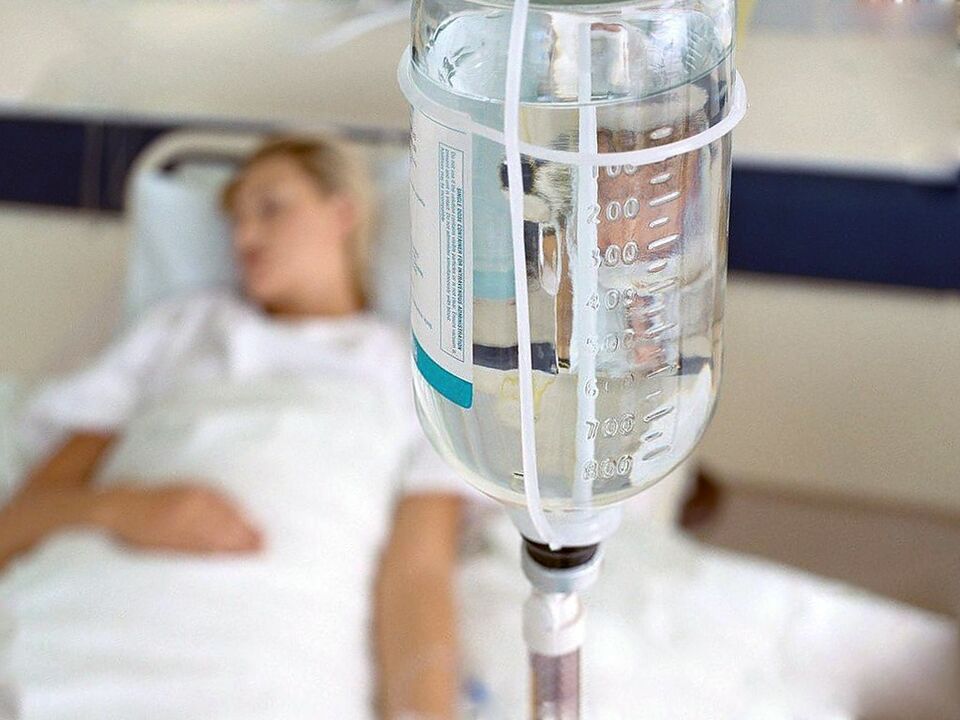
The treatment of psoriasis depends on the form and stage of the disease and the susceptibility to drugs. Traditional medicine focuses on drug use. Treatment is started with topical preparations that act on the affected skin. In this way, they try to avoid the side effects that occur when taking medicines orally. Further details on the use of local remedies are provided below. Now stick to the tablets and capsules.
There is a technique where the patient is first offered a gentler drug with the fewest side effects. If they are not effective, they are replaced with stronger ones, and so on. Even if the treatment is right for the patient, it will change over time. The situation is that the body gradually becomes accustomed to the drug and its effect decreases.
Oral systemic drugs are very effective. It is prescribed for moderate to severe stages of the disease. They help even patients who have not responded to treatment with other devices. However, it has significant drawbacks: they can cause serious side effects, and after the abolition of these funds, the condition worsens again.
| Group of drugs | Dosage form and effect on the body |
| Retinoids - derivatives of vitamin A. | It affects the maturation of the surface layer of the skin and eliminates the disruption of this process caused by psoriasis. Formulation - capsules. Dosage according to the schedule, depending on the stage, 30-75 mg / day. It reduces the rate of division of keratinocytes, promotes normal maturation and differentiation of cells. Available in capsules. The daily dose is 25-50 mg. |
| Immunosuppressants - drugs that reduce the activity of the immune system | It reduces the activity of T lymphocytes, which cause an increased division of skin cells. Sterile solution in ampoules. The initial dose is 3-5 mg / kg / day for intravenous administration and 10-15 mg / kg / day for oral administration. |
| Medicines for the treatment of malignancies (cytostatics) | It inhibits the overgrowth and proliferation of atypical cells in the epidermis. Available in tablets. Order 2, 5-5, 0 mg orally 2-3 times a day, 1 time per week. |
Physiotherapy treatments for psoriasis are very effective. They bring significant relief to patients, stop the progression of the disease, and in some cases serve as safe substitutes for medications.
| Physiotherapy method | Effects on the body |
| PUVA therapy or photochemotherapy | A combination of longwave ultraviolet radiation and internal photosensitization. The course consists of 20-30 procedures. The method is based on UV rays penetrating deep into the skin. The photosensitizer inhibits the DNA synthesis and rate of division of skin cells. Special equipment or cabins are used for treatment. |
| Selective light therapy (S. F. T) | Irradiation of the skin with ultraviolet rays of 280-320 nm. The course consists of 15-35 procedures. A special cabin is required for therapy. |
| Monochrome UV treatment | Exposure to each focus with a separate laser or lamp with UV radiation. It allows foci to be irradiated even in hard-to-reach places without affecting healthy skin. It is prescribed in cases where less than 10% of the skin is affected. The process of treatment is 15-30 procedures. |
| Laser therapy | Different wavelengths of laser radiation are used to treat the rash. The laser promotes the rapid absorption of psoriatic plaques and protects against the appearance of scars in place. The number of procedures is determined individually by the doctor for each patient. |
| Electric power | The procedure is performed on a device that is based on a slight effect on the brain with weak electrical impulses. Duration 20-60 minutes. The number of procedures is 10-12. Electric sleep has a calming effect. As a result, nervous system activity normalizes, plaques dissolve, and the period of well-being begins faster. |
| Magnetotherapy | Treatment with magnetic fields has a beneficial effect on the general condition. Itching and inflammation of the skin, joint swelling and pain are reduced, and the psychoemic condition improves. The Betatron device is used for treatment. The duration of the procedure is 20 minutes. Number of students per course 10-15. |
| Ultrasound therapy | It is used as an analgesic, antipruritic and decongestant. Promotes the absorption of scars. The method can be combined with drug administration (phonophoresis). The exposure time for an area is 15 minutes. It takes 7-14 times to achieve the therapeutic effect. |
| Hyperthermia | Heating the fabrics to 40 degrees with special pads with a heat mixture. This effect on the body normalizes the functioning of the immune system and reduces the number of skin attacks. The duration of the procedure is about 2 hours. Their number is determined by your doctor. |
| Bee venom treatment | The substance is introduced into the body by electrophoresis or ultrasound. Anti-inflammatory, absorbent, antipruritic effect is achieved. Metabolism is normalizing. Minimum number of procedures 10. |
For those with scaly lichens, diet is very important. Eating disorders can make the disease worse. The menu should be rich in vitamins and at the same time simple. It should relax the intestines and liver and not allergenize the body.
| Authorized products | Prohibited foods |
| Vegetables (pumpkin, watermelon, beet, carrot, potato, radish) | Animal fats |
| Fruits (apricots, peaches, apples), juices | Alcohol |
| Berries (excluding red berries: strawberries, raspberries, currants) | Fatty meat (pork, duck) |
| Fresh herbs | Smoked meats |
| Lean meat (veal, beef, rabbit, turkey) not more than 200 g per day | red fish |
| Cheese, cottage cheese, dairy products | Carbonated drinks and coffee |
| Nuts | Egg |
| Low fat fish | Ice cream and smoothie |
| Seaweed | Minimal amount of sweets and sugar |
| Whole wheat bread | Butter and puff pastry |
Fasting days should be taken twice a week to cleanse the body of toxins and metabolites. Kefir, apples and vegetables are recommended.
What ointments are effective in treating psoriasis?
The use of anti-psoriasis ointments provides the greatest effect compared to other external formulations. The ingredients of the ointment do not remain on the surface of the plaque, but soften the scales and get inside the skin.
A large number of ointments are available to treat psoriasis. Appoint in the first stagesnon-hormonal ointments.
In case the treatment has not produced the expected effect, prescribe ithormonal ointments. . . Treatment begins with lighter medications with minimal side effects. If improvement is not achieved, stronger ointments with glucocorticosteroids are prescribed.
| The name of the ointment | Drug action | Side effects |
| Weak ointments | It suppresses the increased activity of leukocytes, prevents them from entering the skin, eliminates the feeling of tightness and itching. | Swelling of the skin, itching, redness of the skin. |
| Moderate ointments | It has anti-inflammatory, anti-allergic, anti-edematous and anti-pruritic effects. Suitable for patients with exudative forms of psoriasis, reduces bleeding. Apply in a thin layer 2-3 times a day to confined areas. The treatment lasts 10-14 days. | Steroid acne, atrophy and stretching of the skin, burning, itching, hypopigmentation. |
| Strong ointments | Topical anti-inflammatory, antipruritic and antiallergic agent. Reduces skin moisture. Apply to the affected area 2-3 times a day for up to two weeks. It is used during exacerbation. | Skin atrophy. |
| Very strong ointments | It has a strong anti-itching and anti-allergic effect. It slows down the processes of cell division and keratinization. Apply 1-2 times a day for up to two weeks per course. | Acne, hair loss, skin atrophy. Do not use in pustular and widespread plaque psoriasis. |
Pharmaceutical companies produce a number of drugs in the form of ointments. The doctor will individually select the medication for the patient and replace it with a stronger one if necessary.
Remember that you should never miss a doctor's appointment for psoriasis. After all, this disease can hide the initial stage of skin cancer.
Choosing a treatment regimen for psoriasis is a lengthy process that involves a lot of trial and error. Don’t despair if you can’t find your "own" medication right away. Keep in mind that many will achieve lasting improvement if the disease does not return for years. You can do it too!























